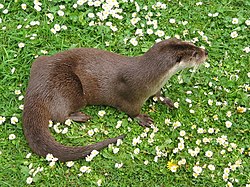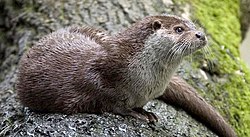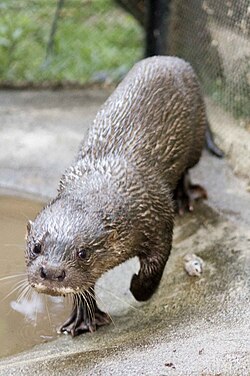Diet
The otters' diets consist mainly of fish (hence, the aquatic environment). However, during the winter and in colder environments, fish consumption is significantly lower and the otters use other resources for their food supply. Their diets can consist of amphibians (mainly frogs and pond turtles), bird predation (mainly anserine species), small rodents, and invertebrates such as water beetles, snails, and crayfish. They have also feed on plants, specifically grasses. With this large diversity of prey and resources for their diets, otters are considered "opportunistic eaters". [4]
Behavior
Some otters live in solitude, while others live in groups.
Lutra species are known to exhibit strong territorial behavior. Family group territories are distinct from those of solitary male Lutra. In a family group, adult males can be seen patrolling and defending their territories while females will raise their cubs in a secure area within the males' territories. Additionally, a family group choose areas that are rich in resources to support their cubs during the first year. Solitary males, however, choose their territory for reproductive purposes and ensure they have access to breeding females. These territories are marked with spraints as a means to claim ownership and deter rivals. As a result, there are overlapping boundary zones that cause many conflicts between males and is resolved through threatening signals and avoidance. [5]
This page is based on this
Wikipedia article Text is available under the
CC BY-SA 4.0 license; additional terms may apply.
Images, videos and audio are available under their respective licenses.













